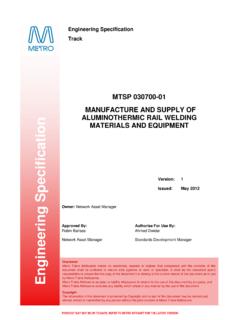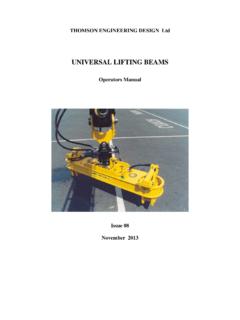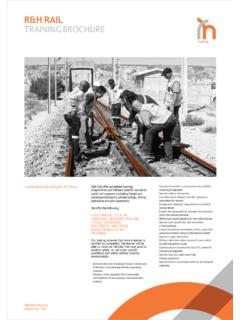Transcription of ULTRASONIC BROKEN RAIL DETECTOR Overview
1 TTHHEE MMOOSSTT AADDVVAANNCCEEDD SSYYSSTTEEMM FFOORR BBRROOKKEENN RRAAIILL DDEETTEECCTTIIOONN The ULTRASONIC BROKEN rail DETECTOR is designed to reliably detect breaks in train rails under all environmental conditions. Whilst increasing operator efficiency and profitability, the ULTRASONIC BROKEN rail DETECTOR is easy to install and maintain, and requires no track modification. The design of the system also makes it suitable for solar powered, remote operation. The system features special signal processing and diagnostic techniques to ensure reliable operation and section coverage up to 1000 meters. UULLTTRRAASSOONNIICC BBRROOKKEENN RRAAIILL DDEETTEECCTTOORR OOvveerrvviieeww Page 2 of 2 ULTRASONIC BROKEN rail DETECTION 1. Overview Many methods are employed to improve the reliability and the timeliness of detecting rail breaks on the lines of railways throughout the world.
2 Some of the most effective methods are: Patrolmen Employed to inspect the railway line at a given inspection frequency. ULTRASONIC and Magnetic scanning Sophisticated detectors are usually mounted on motorized rail vehicles to scan the rail for defect-growth to enable initiation of proactive maintenance tasks before a catastrophic event occurs. Some railways also employ manually operated systems to reduce the period between scans. Track circuits Track circuits provide a varying degree of BROKEN rail detection depending on the configuration employed. In cases where only one rail is used as a Signal rail , BROKEN rail detection is not guaranteed on the other rail especially where this is employed as an electric traction return conductor. Train personnel Reporting detection (experiencing) of a BROKEN rail . All of these detection methods are intermittent resulting in extended periods during which a rail break can occur and be undetected.
3 The introduction of advanced train control systems, such as Positive Train Control, may make the need for wayside signals (and track circuits) redundant, thus the need for alternative technologies for detecting BROKEN rails. 2. Unique Features and Benefits The Railsonic ULTRASONIC BROKEN rail DETECTOR system is the first and only alternative (to track circuits) BROKEN rail detection system developed, produced and implemented on a large scale. By investing in an ULTRASONIC BROKEN rail DETECTOR system railway operators will have the benefit of monitoring rails continuously for BROKEN rails without human intervention. This investment will contribute to ensure that the client does not suffer losses as a result of train derailments. Page 3 of 3 Benefits to the client are: Continuous monitoring for BROKEN rails without human intervention. Increased operational efficiency of the railway line.
4 Client will know where the break occurs (with a 1km resolution). The system is designed to operate from solar power. It is not maintenance intensive, requires no rail modification other than rail bonding for lightning and surge protection, and is easy to install. Page 4 of 4 3. System Description General The operation of the system is based on a simple transmit-receive confirmation protocol. An acoustic signal is generated and inserted in the rail at one location (transmitter), propagates along the rail , and is received at a remote location (receiver). The integrity of the rail between the transmitter and receiver is confirmed as long as an acceptable signal is received. Should the rail develop a clean break between the transmitter and receiver, the inserted signal will not be received resulting in the generation of an alarm.
5 The ULTRASONIC BROKEN rail DETECTOR consists of the following major components: Transmitter Module Receiver Module Cabinet with Power Supply and Communication Equipment ULTRASONIC Transducer and Cable rail Clamp Alarm Terminal Principle of Operation High voltage driving bursts generated by Transmitters are converted into acoustic energy by the rail mounted Transducers, and propagates in both directions in the rail . Arriving at Receiver stations, the acoustic energy is converted into electrical signals by the rail mounted Transducers. These signals are filtered, amplified, and processed to ensure that only valid signals are recognized. The absence of a valid signal at a Receiver signifies a severely cracked or BROKEN rail in the specific rail section. Transmitters and Receivers are interleaved.
6 A specific Receiver receives signals from both rail directions (up and down). To enable Receivers to determine the direction from which acoustic energy originates, Transmitters insert a burst train consisting of 5 pulses at a preset Burst Repetition Interval (BRI) into the left rail , followed by a sequence at a different Burst Repetition Interval into the right rail . The BRI s are set differently at adjacent transmitters. Burst trains are repeated at a specific Interrogation Interval (II). Page 5 of 5 To ensure that received burst trains from the Up and Down directions do not overlap for extended periods at a specific Receiver, causing false alarms, adjacent Transmitters are factory set to different Interrogation Intervals (II). Receivers measure the pulse intervals to identify the direction of the specific Transmitter station. For this purpose, Receivers are also individually set to Right Left Right rail Left rail Burst Repetition Interrogation Interval Burst Injection Scheme Page 6 of 6 recognise specific pulses as arriving from either the Up, or Down direction, depending on the settings of adjacent Transmitters.
7 Receivers recognise valid signals using the following filtering criteria: (a) signal frequency, (b) burst length, (c) burst repetition interval and (d) burst train continuity. Severe continuous noise at a Receiver will jeopardize valid signal detection, regardless of DETECTOR efficiency. An approaching train will manifest as a typical case. Under such circumstances, the Receiver will indicate Train in Section , stop processing received signals, and remain dormant until the noise subsides, after which it will activate and resume normal functioning. Transmitter Module Description Transmitter Modules generate precisely timed high voltage burst sequences for excitation of ULTRASONIC sound waves in train rails. Electronics consist of a Processor with digital timing and conditioning circuits, Real Time Clock, Inverter Circuit to generate high voltage supply for the Pulse Amplifier, Pulse Amplifier, and LED Display Board, all housed in a plastic enclosure.
8 rail mounted ULTRASONIC Transducers are connected to the Module Front Panel using coaxial cable and SMA front panel screw type connectors. Transmitter Module Page 7 of 7 Receiver Module Description The Receiver consists of two separate analogue amplifier and filter circuits which generate triggers when received signals comply with the signal discrimination criteria, frequency, burst length, and amplitude. Triggers interrupt the Processor which then executes interval timing routines. A Code Detection algorithm is used to recognise valid burst trains, and to reject spurious noise. rail mounted ULTRASONIC Transducers are connected to the Module Front Panel using coaxial cable and SMA front panel screw type connectors. Receiver Board Page 8 of 8 GSM Module A custom GSM (cellular) is available to deliver the following alarm messages to the Alarm Terminal: Up Left Alarm (Up Left Normal) Up Right Alarm (Up Right Normal) Down Left Alarm (Down Left Normal) Down Right Alarm (Down Right Normal) Train Presence Battery Voltage Low (Battery Voltage Normal) Cabinet Door Open (Cabinet Door Closed) Alarm status of a specific Receiver Unit can be polled via the GSM network.
9 GSM Module Page 9 of 9 Alarm Terminal A custom Alarm Terminal is available as a stand alone unit. The rail section configuration is displayed with indication of BROKEN rails, GSM communication errors, equipment failures, and sections booked out during repair actions. Page 10 of 10 4. Intended Use The ULTRASONIC BROKEN rail DETECTOR is specifically designed to achieve a continuous inspection of the rail status. In its current form a complete installed line can be scanned for rail breaks down to 3 minute intervals (called the interrogation period), depending on train length and traffic density. On the OREX line in South Africa, the Interrogation Interval is set to 15 minutes to conserve energy consumed from the solar power supply system. The longest period for which a BROKEN rail can go undetected, is thus equal to this settable Interrogation Interval.
10 Given the arguments above, it should be noted that the ULTRASONIC BROKEN rail DETECTOR is not classified Fail Safe , although many fail safe principles have been incorporated in order to detect and reveal most of the equipment failures. It is however conceivable that certain failure modes could occur which is undetectable and can cause the system to indicate that a section of rail is intact, while an actual rail break could be present. Thus it is important to note that the system is employed as a fast turn around inspection system with greatly improved break detection reliability as compared to currently employed break detection methods. Careful attention has been given to system and lay-out design to ensure that equipment failures are detectable and will not manifest as false alarms. With the centre fed Transmitter configuration for example, a failed Transmitter Module will result in simultaneous signal loss in all four sections of rail interrogated by it.






